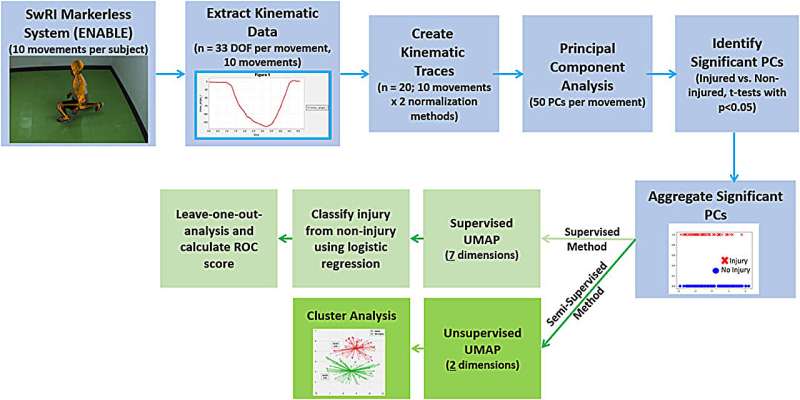This article has been reviewed according to Science X's editorial process and policies. Editors have highlighted the following attributes while ensuring the content's credibility:
fact-checked
trusted source
proofread
Using markerless motion capture to assess injury risk in soldiers

Southwest Research Institute (SwRI) is using markerless motion capture to identify musculoskeletal injury risks in military service members during specialized training. A study published in the journal Frontiers in Bioengineering and Biotechnology describes how the SwRI-developed Engine for Automatic Biomechanical Evaluation (ENABLE) analysis tool can help identify individuals at risk for noncombat injuries before they occur.
"Noncombat musculoskeletal injuries during military training cost the U.S. military more than $3.7 billion annually," said SwRI Senior Research Engineer Dr. Lance Frazer, the study's lead author. "Biomechanical analyses—used in a range of applications—typically require specialized equipment and laboratory spaces. Getting out into the field where activities are occurring is crucial. The ability to use markerless motion capture technology is like the difference between having a landline and a cell phone."
Markerless motion capture leverages computer vision algorithms to capture 3D motion data for biomechanical analysis in research, clinical, and sport science applications—without the need to attach physical body markers to human subjects. ENABLE combines SwRI's biomechanical modeling expertise with computer vision and deep learning to develop powerful algorithms that enable accurate, reliable markerless motion capture.
"In this study, we evaluated the effectiveness of a markerless motion capture system and full-body biomechanical movement pattern assessments to predict injury risk among military trainees," Frazer said.
In collaboration with the U.S. Air Force Special Warfare Human Performance Squadron, SwRI screened more than 150 U.S. Air Force trainees performing multiple functional movements. Then, ENABLE analyzed the video data to identify trainees at risk based on their movements.
"We looked at the motion of the entire body, whether we thought it was relevant or not, and used that to come up with a predictive algorithm to determine injury risk," Frazer said. "We found that it's necessary to analyze the body's entire motion in aggregate to develop a better predictive model, which is especially useful when taking measurements in the field."
ENABLE's predictive model correctly predicted 70% of the injuries that occurred among trainees across an eight-week training course while accurately predicting 87% of the non-injuries.
"We believe this approach offers a novel way to proactively address one of the largest non-combat burdens on the U.S. military," Frazer said. "Further refinement and wider-scale implementation of these techniques could bring about substantial injury reductions."
The work is published in the journal Frontiers in Bioengineering and Biotechnology.
More information: Lance Frazer et al, Identifying special operative trainees at-risk for musculoskeletal injury using full body kinematics, Frontiers in Bioengineering and Biotechnology (2023). DOI: 10.3389/fbioe.2023.1293923




















